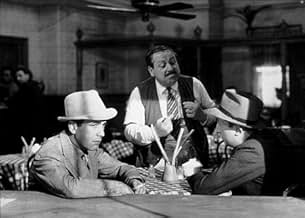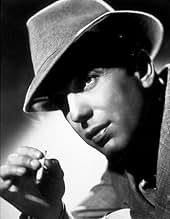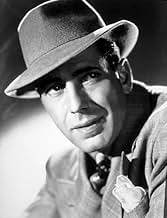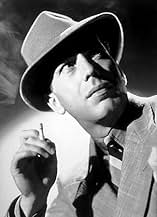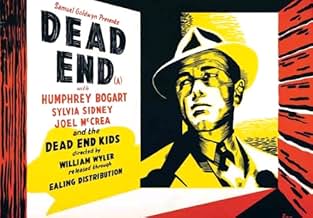IMDb RATING
7.2/10
9.3K
YOUR RATING
The lives of a young man, a young woman, a notorious gangster, and a group of street kids converge one day in a volatile New York City slum.The lives of a young man, a young woman, a notorious gangster, and a group of street kids converge one day in a volatile New York City slum.The lives of a young man, a young woman, a notorious gangster, and a group of street kids converge one day in a volatile New York City slum.
- Director
- Writers
- Stars
- Nominated for 4 Oscars
- 1 win & 4 nominations total
Leo Gorcey
- Spit
- (as Leo B. Gorcey)
- Director
- Writers
- All cast & crew
- Production, box office & more at IMDbPro
Featured reviews
This movie is not only a great story, it is a great social commentary on the divisions between rich and poor. The main story concerns the return of a gangster to his old neighborhood, but a couple of side stories concern the gang of kids who seemingly idolize the hood and the rich people who live in a luxury apartment that is next to the slum. This film could be made today because the conditions that are in the film still exist today only they are a hundred times worse because the gap between the rich and the poor in this country have widened even more. This film should be shown more on television
Now here's a fascinating world from the late 1930s, where they're not really angels but they still have faces dirty, where the rich butt up with poor, as they wander through their backdoor, and the disconnect provokes and displeases. The kids of the Dead End are always causing trouble, as they live their lives in a ghetto like bubble, observed by 'Baby Face' Martin, who's returned to be disheartened, this villain prefers knife over knuckle. You're left with a feeling that the worlds on the cusp, a self-destructive nature that might leave it in dust, but four years later a falcon will rise, and a year after that a white house will surprise.
The main credit of "Dead End" lies in the stunning visual beauties. The studio reproduction of a New York slum is really magnificent, worth of other major achievements of the same kind, like, say, the set of "Rear Window". A true joy for the eyes. The work of the camera and William Wyler's direction are outstanding, as well. And, of course, the job of the cast is great. Bogart, still in the role of the villain, McCrea and Sylvia Sidney are excellent, and save their rather straightforward characters and lines. In my opinion, the best one is Claire Trevor, in the small part of the lost girl. I normally dislike kids on the screen, but I must concede that here they give great performances, playing the gang of street-boys.
The story is conventional, with a noble message, but few and predictable twists. The script is often clumsy and preachy. Luckily enough, the director gives a quick pace to the narration and inserts a number of humoristic touches. There's a main flaw in the plot: I think that, even in the States of the 1930s, a common citizen couldn't freely shoot a gangster.
Anyway, I've found in the screen-play an interesting and modern theme, namely the psychological ambiguity of some characters, whom even the all-knowing viewer cannot fully understand. For instance, Claire Trevor is apparently the cliche disgraced girl, the innocent victim of poverty, lack of opportunities, social injustice. To end as a prostitute is her unavoidable doom... But, when her former boy-friend Bogie gives some money to help her, she makes the horribly vulgar request of "twenty more bucks"... with a grimace worth of a hardened prostitute (great stuff by Trevor!). So we see that, after all, perhaps that girl is not so innocent as she pretends to be... And what about Drina's brother, the leader of the street-boys? The audience is perfectly aware that, in spite of his whining, weeping self-apologies (when he's in dire straits), the boy is a REAL criminal. We see that he deliberately harms people, steals, brutally thrashes the rich kid, wants to slash his gang-mate. And he just mocks his affectionate sister and his friend McCrea when, in tears, he cries that he's good, that he didn't intend to harm, and all that. So, are we supposed to feel sympathy for this hideous boy? Interesting ambiguity, which creates a fine artistic effect... perhaps beyond the actual intentions of the writer Lillian Hellman.
All in all, we may forgive the defects of the movie. it is worth seeing "Dead End", enjoying the beauty of the set and the work of director and actors.
The story is conventional, with a noble message, but few and predictable twists. The script is often clumsy and preachy. Luckily enough, the director gives a quick pace to the narration and inserts a number of humoristic touches. There's a main flaw in the plot: I think that, even in the States of the 1930s, a common citizen couldn't freely shoot a gangster.
Anyway, I've found in the screen-play an interesting and modern theme, namely the psychological ambiguity of some characters, whom even the all-knowing viewer cannot fully understand. For instance, Claire Trevor is apparently the cliche disgraced girl, the innocent victim of poverty, lack of opportunities, social injustice. To end as a prostitute is her unavoidable doom... But, when her former boy-friend Bogie gives some money to help her, she makes the horribly vulgar request of "twenty more bucks"... with a grimace worth of a hardened prostitute (great stuff by Trevor!). So we see that, after all, perhaps that girl is not so innocent as she pretends to be... And what about Drina's brother, the leader of the street-boys? The audience is perfectly aware that, in spite of his whining, weeping self-apologies (when he's in dire straits), the boy is a REAL criminal. We see that he deliberately harms people, steals, brutally thrashes the rich kid, wants to slash his gang-mate. And he just mocks his affectionate sister and his friend McCrea when, in tears, he cries that he's good, that he didn't intend to harm, and all that. So, are we supposed to feel sympathy for this hideous boy? Interesting ambiguity, which creates a fine artistic effect... perhaps beyond the actual intentions of the writer Lillian Hellman.
All in all, we may forgive the defects of the movie. it is worth seeing "Dead End", enjoying the beauty of the set and the work of director and actors.
i'm a huge Bogey fan, so naturally i'll watch anything with his name in the credits. however, i was not prepared for "dead end." this is one of the most brilliant films i've ever seen and i can't understand why the eberts and roepers and maltins never talk about this one. it begins as a familiar story, rich vs. poor along the east river. a gang of kids hang around outside the ritzy, new apartments in the neighborhood. tommy, it's leader and his "friends" notice a boy who has been earning pocket money as a babysitter. when tommy steals his money, a fight breaks out. off in the distance, two men in silk suits watch the fight. tommy's sister drina breaks up the fight. drina is a working class woman on strike, trying to earn the money she deserves. Dave is her on-again, off-again love interest who has done everything in the book to try to rise out of poverty, but still can't get ahead. Dave has been seeing Kay, a young woman torn between a future with a man she thinks she may love (Dave) and the comforts of wealth. we find out the two men in silk suits are gangsters, one being the famous killer, baby face martin, who has returned to his home to see his mother and old girlfriend. he is rejected by his mother, who is disgusted by his profession and track record and his girlfriend, who has become a common prostitute. their are a million intertwining story lines that add up to one incredible climax, but essentially this film is about the cycle of poverty and class issues. the performances are terrific. Sylvia Sidney (not a big name today, but a damn good actress) and Joel mccrea are perfection as the films heroes. Bogart is unforgettable. this is one of the dozens of gangsters he played, but i would rate this performances as high as duke manatee in petrified forest. he's tough and street smart, but with each disappointment we see evidence of his emotions leaking out. the gang of kids remind me of the jets in west side story- they don't like anyone, not even each other half the time. look for Marjorie main (ma kettle before she was ma kettle!) in a touching, but heartbreaking scene as Bogey's frail, aging mother and Claire Trevor (another fine, forgotten actress) as Bogey's sweetheart turned greedy streetwalker. the best thing about this film is they way each character believes he or she can overcome the way of life he or she seems fated to live with. each character tries desperately and fails. this is the way real people are. there's no Hollywood, sugar-coatedness about any of it. no over-dramatic music or made-for-the-previews lines. it's grossly realistic. this film would be on my top 50 list, maybe even my top 25. it's that good.
Considering all the talent involved, it was hardly surprising to find this a first rate movie. Didn't you want to slap Bogart around ... well, that is actually what compelled me to make this entry. Among the handful of superlative cameo (say 2 to 8 minutes in length)performances I have seen in my 40 plus years of movie-going, Dead End features one of them.
Marjorie Main, almost as unlikely a film character (think Ma Kettle!) as one could imagine, turned in what I consider a masterpiece. Read that she repeated her stage role, and wow, that slap, that dialog and that role. Bravo!
Marjorie Main, almost as unlikely a film character (think Ma Kettle!) as one could imagine, turned in what I consider a masterpiece. Read that she repeated her stage role, and wow, that slap, that dialog and that role. Bravo!
Did you know
- TriviaWilliam Wyler gave Claire Trevor an old purse and broken high heel shoes. He had her minimize her make-up and ordered her not to comb her hair when she got up in the morning. He wanted her to look like the downtrodden character she was playing.
- GoofsBaby Face Martin suddenly appears from nowhere and is leaning against a railing as the boys are fighting.
- Crazy creditsOpening credits prologue: Every street in New York ends in a river. For many years the dirty banks of the East River were lined with the tenements of the poor. Then the rich, discovering that the river traffic was picturesque, moved their houses eastward. And now the terraces of these great apartment houses look down into the windows of the tenement poor.
- ConnectionsFeatured in AFI Life Achievement Award: A Tribute to William Wyler (1976)
- SoundtracksBoo-Hoo
(1937) (uncredited)
Music by Carmen Lombardo and John Jacob Loeb
Lyrics by Edward Heyman
Played at the upstairs party and sung by Huntz Hall in the street
- How long is Dead End?Powered by Alexa
Details
Box office
- Budget
- $300,000 (estimated)
- Runtime
- 1h 33m(93 min)
- Color
- Aspect ratio
- 1.37 : 1
Contribute to this page
Suggest an edit or add missing content



